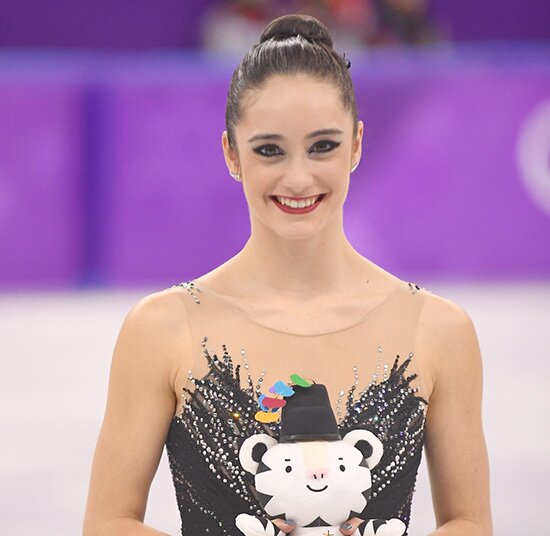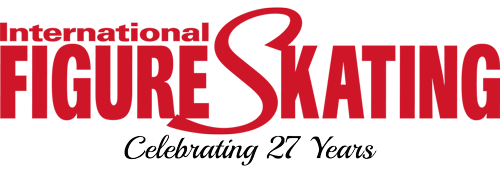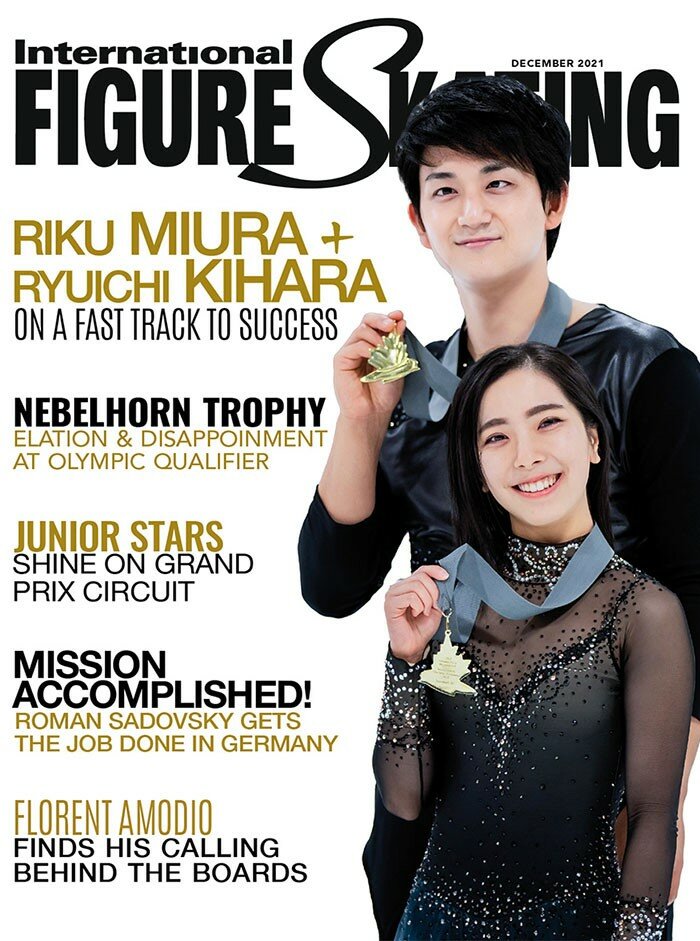

As a young girl from a small town in Canada’s easternmost province, Kaetlyn Osmond dreamed of being in the spotlight and performing in ice shows. Being the centre of attention was what it was all about for her, but she knew the only way to achieve that goal was to make a name for herself in the competitive world.
With three Olympic medals — one of each color — from two Winter Games and a World crown to her credit, the girl from Marystown surpassed all her childhood dreams.
Kaetlyn Osmond became the centre of attention in ladies’ figure skating, in more ways than she ever imagined last season.
That attention continued with her post-season performances in shows around the world, most recently in Japan, South Korea and a cross-Canada tour — all in a dizzying stretch of six weeks through April and May. Every night, Osmond heard the words “World champion” as she was introduced. But even that was not enough to fully cement the reality of what happened on a March evening in Milan, Italy, when she became the first Canadian to earn that distinction since Karen Magnussen in 1973.
“I always dreamed of going to shows and being part of shows and I knew I had to compete and make a name for myself to get the good spots in them,” said Osmond who can laugh now when she is reminded about how and why it all began. “It’s definitely still hard to believe I’ve been able to get this much out of my career already, just because I wanted to be the centre of attention.”
The World title came a mere three weeks after the 22-year-old claimed the bronze medal at the Olympic Winter Games. Osmond remembers thinking to herself as she watched Joannie Rochette achieve that feat in Vancouver in 2010, “that’s cool, but I’m never going to be able to do that.”
Behind her natural humility, however, is the confident voice of a young woman whose belief in herself and her ability as a skater has taken her to heights she felt for too long were elusive and unreachable. Even though she claimed silver at the 2017 World Championships, it was not until she medaled in PyeongChang that Osmond felt she truly belonged in the same league as skaters such as Alina Zagitova and Evgenia Medvedeva.
“Last year, I caught a little shimmer of it, especially at Worlds when I came second. It hit me then that I can make the podium, that I can be one of the best if I keep going this way,” said Osmond, who, for the first time, medaled at every event she contested last season. “This year, in competition, I started to feel like I deserved it, and realized that I’m not just hitting the podium because I skated well and the rest of the field didn’t. I was hitting the podium because I was skating well, fighting against even harder programs and against great skaters. I also saw that my score was getting closer and closer to the two Russians that beat me at the Olympic Games. That meant a lot to me.”
Even a little blip at the Canadian Championships in January, where she finished second behind Gabrielle Daleman, did not diminish her confidence. Rather, Osmond followed the path of one of her choreographers, Jeffrey Buttle, who placed second behind Patrick Chan at 2008 nationals and went on to win Worlds two months later. Osmond attended those nationals where her older sister, Natasha, competed in junior ladies. Osmond stayed to watch that men’s event.
It’s a story she was reminded about at nationals this year by Tessa Virtue, Scott Moir and Eric Radford. “Each person kept reminding me that Jeff came second that year and he won Worlds,” said Osmond. “I kind of laughed and said, ‘well, I’m not going to win Worlds.’”
In an ironic twist, it was Buttle who choreographed the “Black Swan” long program that took her to both the Olympic and World podiums last season. The intricate routine, with seven triple jumps, was one the naysayers suggested Osmond would not be able to skate cleanly in competition. That proved to be the extra fuel she needed to push her to the two biggest free skate scores of her career. “I got 142 at Worlds last year and my mark just seemed to not want to go above it until Olympics this year,” she said of her long program score in Korea (152.15).
“Going into the Olympics, I heard so many people say that my long program is not consistent enough, and I was like, ‘no, it is.’ I knew I could do it. I was terrified the entire day of the long program that I couldn’t speak. I was shaking, which was a different sensation for me. I do get nervous, but not that bad. When my name got called and I got into my starting position, I thought ‘why am I nervous? This program, I can do it.’ And that’s exactly how I felt the entire time. I felt like I was doing my job, one thing at a time. I was so focused and in the moment.”
Ravi Walia, who has coached Osmond since she moved to Edmonton, Alberta, with her family as a 10-year-old, was not surprised that his prized protégé was able to rise to the biggest moment of her skating life. It is something he has come to expect of a skater for whom mental strength has become a huge asset. “I have never doubted that Kaetlyn was capable of performing at her best when it mattered the most,” he said. “I’ve coached her for 12 years and she is a very fierce competitor.
“She showed that at the Olympic Games, under a lot of pressure in that free program, skating in the last group. I know she was very nervous, but she really is so mentally strong, and it showed right there in that moment. It was definitely a dream year.”
GLOBAL GLORY
An even bigger test lay ahead after Osmond returned home from PyeongChang on the ultimate high. Not only did she have a medal to call her own, she had kicked off her Olympic experience as a member of Canada’s gold medal winning crew in the Team Event.
“We’ve become so close over the last couple of years. They treated me amazingly and helped me grow up in this sport,” Osmond said of her teammates. “Being on the podium with them and seeing their faces and their happiness gave me so much joy.”
Back home, that energy soon evaporated, but there was still the matter of preparing to peak again a month later at the World Championships. “That was probably the toughest thing I’ve ever done in my life,” said Osmond. “Coming home from Olympics … I had just given three weeks of energy and so many different emotions, and I just felt drained. Mentally, physically … I just couldn’t imagine that I’d have to get myself together to compete again in a matter of weeks. I honestly didn’t think I was going to be able to do it.
“I showed up at the rink for the first day of training after the Olympics, and I cried. I was so tired I couldn’t even tie my own skates. Ravi would tell me to do something, and I would just cry. I would do it because I had to, but it always amazed me that I was still going to compete. What really motivated me for Worlds, was that I didn’t want my performance in PyeongChang to be ‘a fluke. I wanted it to be, ‘no that wasn’t a mistake, I didn’t just do a clean long program because it was the Olympics.’ I went to Worlds to prove again that I could do this long program.”
During her first practice in Milan, she injured her ankle, but kept pushing forward. When her short program score left her in fourth place, more than seven points behind the leader heading into the free skate, it seemed it was now about finding her way back to the World podium. But as it turned out, Osmond had much more waiting for her.
Skating first in the final group in the free, the three-time Canadian champion nearly matched her performance in PyeongChang, posting a 150.50 score for a program that she had to battle through to the finish. “At the Olympics, after my long program, I was buzzing with energy and felt like I could do another four programs afterwards.
“But at Worlds, when I hit my ending, I felt so relieved. I remember that halfway through my program, I was quest- ioning how I was going to do it, but I had reached the point of exhaustion and my brain just shut off. I was like, ‘you know what, no. You’ve trained the entire year, you’re going to finish this program.’ I was really glad in those moments that I was trained, and I could do everything on autopilot.
“I remember getting off the ice, giving Ravi a hug and saying, ‘I did it.’ I almost felt more proud after that long program than I did at the Olympics.” But, the drama in Milan was far from over. Osmond had to watch five other competitors before knowing whether she would claim a second straight World medal. One by one, they failed to surpass her score. Eventually, it came down to Carolina Kostner, the final skater.
“Watching Carolina skate, I thought, how amazing would it be to win Worlds again in your country,” said Osmond, who was a first-year senior when Kostner won Worlds in 2012. “Then I saw her fall and I just looked at Ravi and he said, ‘don’t get your hopes up.’ I said OK. Then there was another mistake and he said, ‘you know what, just plan for the worst.’ And I was like, ‘the worst is second. I can’t really plan for the worst.’
“I remember hearing Ravi say that ‘her technical is too low.’ I just looked at him and I didn’t believe what he was saying until her scores came up.”
What happened in the next few minutes remains a blur to Osmond: Kostner’s scores being below hers (she finished fourth), then all the skaters surrounding her in the green room applauding the new World champion. “When we saw the scores, I covered my face with my hands and looked around and everyone was clapping and looking at me,” Osmond said. “I was sitting there saying, ‘I don’t know what’s going on.’”
As Osmond and the other two medalists, Japan’s Wakaba Higuchi (silver) and Satoko Miyahara (bronze), began their victory lap around the ice following the medal ceremony, Osmond stumbled on a carpet and tumbled to the ice. “My nickname growing up was Bambi. I was continually tripping on things, so I didn’t even question it when I hit the ice,” she said. “I was laughing so hard. Everyone who knows me or watched me grow up mentioned to me afterward that I needed to be able to do that, and I completely agree.
“I don’t even remember tripping. When I picked my feet up I saw the carpet was underneath them and I just sat there and thought, ‘you’ve got to be kidding me.’ But you know what, me winning Worlds wouldn’t have felt real if I didn’t have a moment like that.”
Osmond became only the fourth Canadian lady ever to win a World title, joining Barbara Ann Scott (1947 and 1948), Petra Burka (1965) and Magnussen. “It definitely hasn’t sunk in yet. After Worlds, Karen sent me an amazing email. She told me to wait five months before it will actually set in and then I’ll realize what happened,” Osmond said.
“But I don’t know that it ever will at this point. This entire year has been a whirlwind.”
INSPIRED MOMENTS
To fully appreciate the heights Osmond has now reached, one needs to go back to her lowest point — a day in September 2014 when she suffered a freak fall at a practice session and broke her fibula in two places.
It was just one of a string of injuries, which left her sitting on the ice saying, ‘why does this keep happening to me?’ After her surgery, Osmond knew exactly how to put a stop to it all. While lying in her hospital bed, she looked at her mother and said, “I’m not skating again. I don’t want to.”
When Walia heard those sentiments, he considered everything Osmond had accomplished to that point and was initially prepared to let her have her way. “When I realized that it looked like she wasn’t going to come back to skating, it made me think a lot about the situation,” he said. “I considered just letting her finish. I told myself, she’s been a two-time national champion, top 10 in the world, and she’s been to the Olympic Games. That’s a really great career. I thought maybe this it.”
But Walia realized it could not end there, and that letting Osmond hang up her skates would be a terrible waste of talent and potential. Of course, there was no telling Osmond that at the time — she was broken in ways that went far beyond the two shattered bones in her leg. Instead, Walia and Osmond’s parents appealed to the very thing that first brought her to the ice all those years ago.
“When my parents pushed me to get back on the ice, it wasn’t to compete again,” said Osmond, who was 18 at the time. “They just didn’t want me to be scared of being on the ice and being in my skates.”
She freely admits she has no idea what she would be doing today if she had quit skating, though she suspects she probably would be back in school. But what Osmond does know, is hitting her lowest point was the springboard for everything that has followed. “I’m fully convinced that everything I’ve done since then wouldn’t have happened. I needed that break, I needed that rock bottom feeling of not wanting to skate to actually remind myself about why I do it,” she said.
“Ravi took the time back then to fix my technique and get my jumps feeling a lot better. I needed the mental switch of reminding myself why I was skating. It took me two years and a lot of crying to see the good in it.”
After finishing third at 2016 nationals and not making the World team Osmond asked herself, ‘why am I training every single day and going to competitions, when I’m not able to do it and I’m not making teams? I didn’t fight back from the injury and fight back from the pain it caused to try to get back from that for nothing.’
“Finally, it hit me in that moment — if I’m going to keep doing this, I’m going to do my best and just that little mental switch caused me to put so much more into the sport and get myself in the best shape I’ve ever been in — and get myself the help I needed off the ice.”
Walia had a list of about 15 things he felt Osmond needed to change to make major improvements, and one by one they checked them off. That included getting Osmond to work with a sports psychologist, which Walia said helped her tremendously.
When the 2016-2017 season opened, they rolled out a new and improved version of Osmond and the results followed. She won medals at both her Grand Prix events and qualified for the Final for the first time, where she finished fourth. Osmond regained her Canadian title in Ottawa, and went on to a silver-medal finish at 2017 Worlds.
The roll continued into the 2017-2018 campaign, with a victory at Skate Canada and a bronze-medal finish at the Grand Prix Final, followed by the results at Olympics and Worlds. The entire process taught Osmond so much about herself. “I’ve learned I’m a lot stronger than I thought I was, and that I’m capable of a lot more things than I ever believed I would be,” she said. “I learned I had to set my mind to it and just say ‘I have the ability to be the best in the world.’ I had always put the effort in, but I never believed it.”
Those are the lessons she took with her to Newfoundland last April, when the province welcomed Osmond with a reception worthy of a World champion. There were dozens of people waiting to greet her at St. John’s airport when she landed, and three arenas in various parts of the province were filled for ice shows she performed in. One of those, of course, was in her hometown of Marystown, where the local rink was renamed the Kaetlyn Osmond Arena four years ago.
“It was just so incredible. It was so humbling going home, and such an honor,” said Osmond. “It really felt like a huge celebration. My earliest memories of skating and growing up are in that rink. When I went back this time, there were a number of people there I used to skate with and I talked with them. We were just amazed at everything that has happened since then.”
There is now a stretch of highway leading into town called Osmond Way, the latest honor bestowed upon the town’s favorite daughter.
COMING UP FOR AIR
As for what happens next … Osmond is uncertain about her future plans. Though she said she still wants to compete and is not yet ready to hang up her skates, she announced in early June, that she would not be competing in the fall and on Aug. 21 said she would be taking the entire season off. In a statement issued by Skate Canada, Osmond said she needed time to refocus and evaluate the next steps and wants to explore other opportunities.
One of those opportunities will be a nationwide tour that opens in British Columbia in early October and runs through the end of November, with the final stop being in St. John’s.
Osmond is not closing the door on competing in the second half of the season, and said that it is still a possibility. While she is aware her new status as World champion has made her an idol in the eyes of young girls across Canada, she has a hard time seeing herself in that light. “I never thought I’d be a person people would look up to,” Osmond said.
But hers is a story that carries a vital message of hope and perseverance, and she is always eager to share it. “I can now go to others and tell them that it doesn’t matter where you’re from. You can be from a small town or city or fight injuries or just be a natural klutz — I am, Worlds proved it — but if you fight for it and push for it, you’ll find something rewarding comes out of it. Maybe it won’t bring you a World title because there are only so many people in the world that can achieve that, but it can bring a sense of passion and a drive, and take you somewhere you never expected.
“It’s always worth it. There’s always something good that is going to come out of it.”
RELATED CONTENT:
KAETLYN OSMOND: GRACE UNDER PRESSURE



